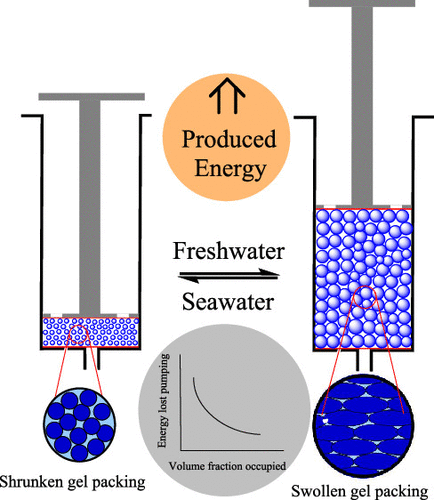当前位置:
X-MOL 学术
›
Ind. Eng. Chem. Res.
›
论文详情
Our official English website, www.x-mol.net, welcomes your
feedback! (Note: you will need to create a separate account there.)
Energy Lost in a Hydrogel Osmotic Engine Due to a Pressure Drop
Industrial & Engineering Chemistry Research ( IF 3.8 ) Pub Date : 2021-08-31 , DOI: 10.1021/acs.iecr.1c00409 Tri Quang Bui 1, 2 , Vinh Duy Cao 1 , Wei Wang 2 , Thanh Hung Nguyen 3 , Anna-Lena Kjøniksen 1
Industrial & Engineering Chemistry Research ( IF 3.8 ) Pub Date : 2021-08-31 , DOI: 10.1021/acs.iecr.1c00409 Tri Quang Bui 1, 2 , Vinh Duy Cao 1 , Wei Wang 2 , Thanh Hung Nguyen 3 , Anna-Lena Kjøniksen 1
Affiliation

|
Utilizing hydrogels to harvest salinity gradient energy from solutions of different salinities has recently attracted interest. Polyelectrolyte hydrogels exhibit cyclic swelling/deswelling when alternately exposed to freshwater and seawater. This can be utilized to convert the mixing energy of the two solutions into mechanical energy. Hydrogels consisting of a semi-interpenetrating network (semi-IPN) of poly(4-styrene sulfonic acid-co-maleic acid) sodium salt and polyacrylic acid was prepared at various cross-linking densities. The energy lost due to a pressure drop in the system during the deswelling/swelling process of these hydrogels is examined, and the effects of tubing dimensions, hydrogel cylinder size, gel particle size, and the volume fraction within the hydrogel cylinder occupied by the flowing liquid (ε) are investigated. In addition, a small-scale osmotic engine was compared to a scaled-up system. ε was found to be the factor that had the largest effect on the energy loss. It was found that ε is strongly dependent on the degree of swelling of the hydrogels. When the hydrogels swell, they deform more easily under pressure. This markedly decreases ε, thereby inducing a high pressure drop in the system and a correspondingly large energy loss. Accordingly, the pressure drop when pumping through the hydrogel is the major contributor to the energy loss in the system. When the hydrogel particles deform too much, the energy needed to pump the flowing liquid through the hydrogels exceeds the energy produced by the system. Developing a hydrogel system that deforms less in its swollen state is therefore essential for improving the energy efficiencies of these osmotic engines.
中文翻译:

由于压降,水凝胶渗透发动机中的能量损失
利用水凝胶从不同盐度的溶液中获取盐度梯度能量最近引起了人们的兴趣。当交替暴露于淡水和海水时,聚电解质水凝胶表现出循环溶胀/消溶胀。这可用于将两种溶液的混合能转化为机械能。由聚半互穿网络(半IPN)的水凝胶(4-苯乙烯磺酸-共-马来酸)钠盐和聚丙烯酸以各种交联密度制备。检查在这些水凝胶的消溶胀/溶胀过程中由于系统中的压降而造成的能量损失,以及管道尺寸、水凝胶圆柱体尺寸、凝胶粒径和水凝胶圆柱体中流动所占据的体积分数的影响。液体 (ε) 进行了研究。此外,将小型渗透引擎与放大系统进行了比较。发现 ε 是对能量损失影响最大的因素。发现 ε 强烈依赖于水凝胶的溶胀程度。当水凝胶膨胀时,它们在压力下更容易变形。这显着降低了 ε,从而导致系统中的高压降和相应大的能量损失。因此,泵送通过水凝胶时的压降是系统能量损失的主要因素。当水凝胶颗粒变形过多时,泵送流动液体通过水凝胶所需的能量超过系统产生的能量。因此,开发一种在膨胀状态下变形较小的水凝胶系统对于提高这些渗透引擎的能量效率至关重要。
更新日期:2021-09-15
中文翻译:

由于压降,水凝胶渗透发动机中的能量损失
利用水凝胶从不同盐度的溶液中获取盐度梯度能量最近引起了人们的兴趣。当交替暴露于淡水和海水时,聚电解质水凝胶表现出循环溶胀/消溶胀。这可用于将两种溶液的混合能转化为机械能。由聚半互穿网络(半IPN)的水凝胶(4-苯乙烯磺酸-共-马来酸)钠盐和聚丙烯酸以各种交联密度制备。检查在这些水凝胶的消溶胀/溶胀过程中由于系统中的压降而造成的能量损失,以及管道尺寸、水凝胶圆柱体尺寸、凝胶粒径和水凝胶圆柱体中流动所占据的体积分数的影响。液体 (ε) 进行了研究。此外,将小型渗透引擎与放大系统进行了比较。发现 ε 是对能量损失影响最大的因素。发现 ε 强烈依赖于水凝胶的溶胀程度。当水凝胶膨胀时,它们在压力下更容易变形。这显着降低了 ε,从而导致系统中的高压降和相应大的能量损失。因此,泵送通过水凝胶时的压降是系统能量损失的主要因素。当水凝胶颗粒变形过多时,泵送流动液体通过水凝胶所需的能量超过系统产生的能量。因此,开发一种在膨胀状态下变形较小的水凝胶系统对于提高这些渗透引擎的能量效率至关重要。











































 京公网安备 11010802027423号
京公网安备 11010802027423号